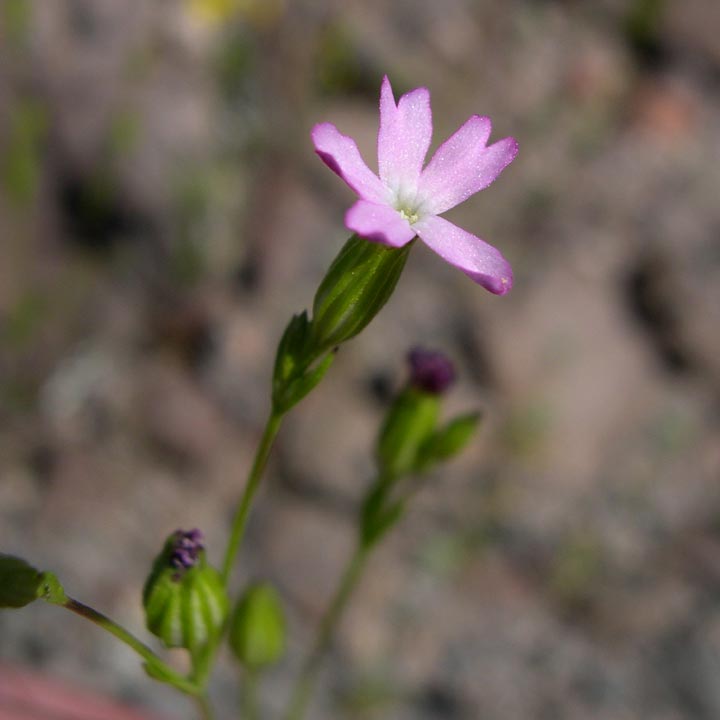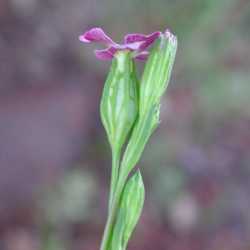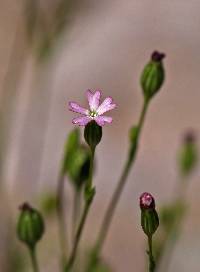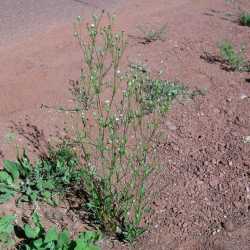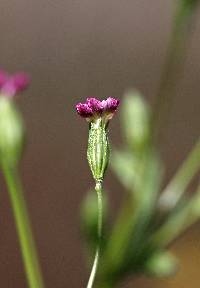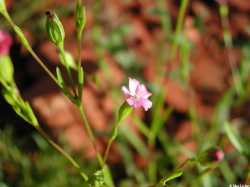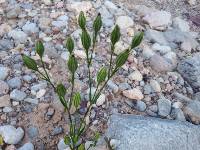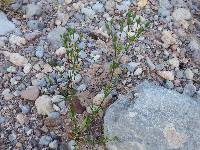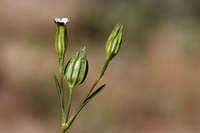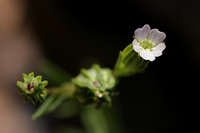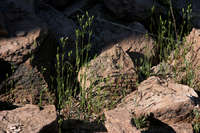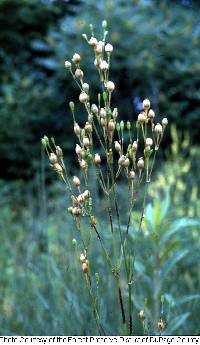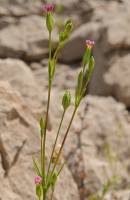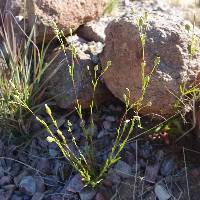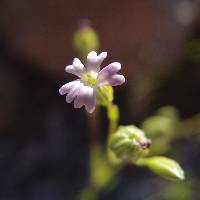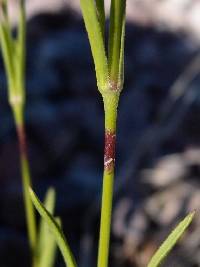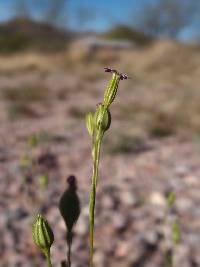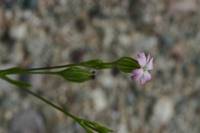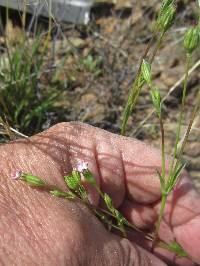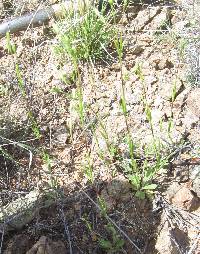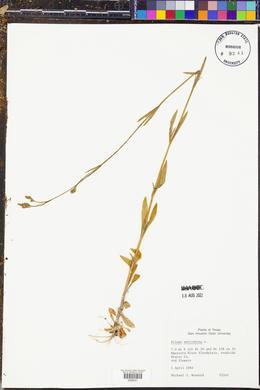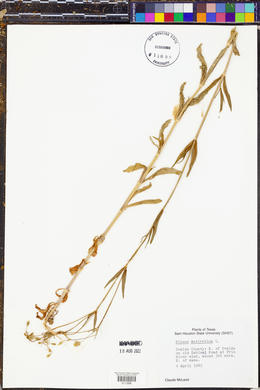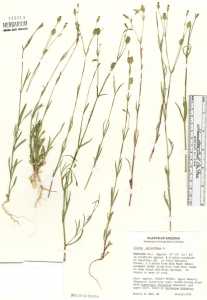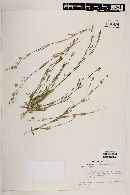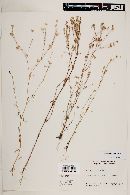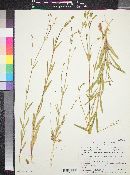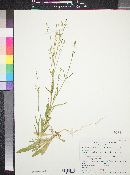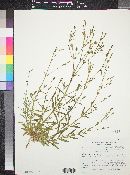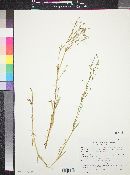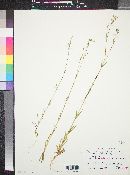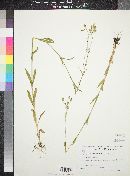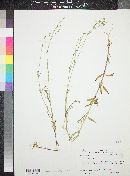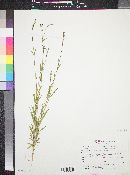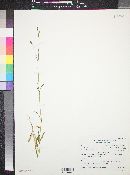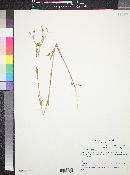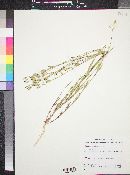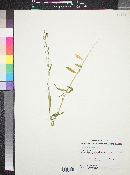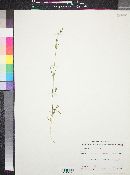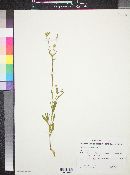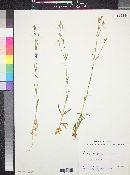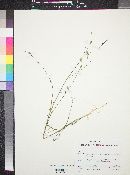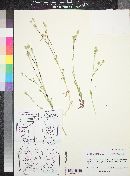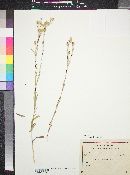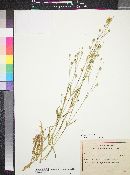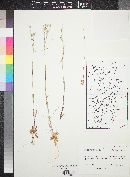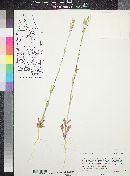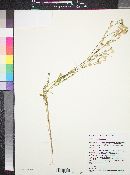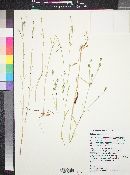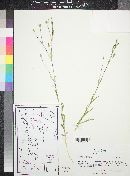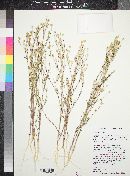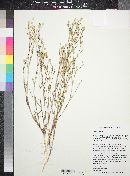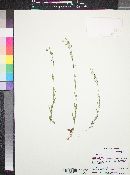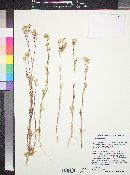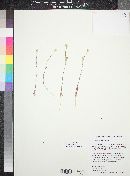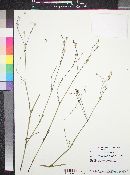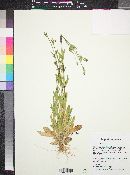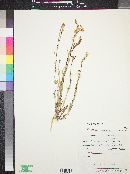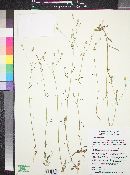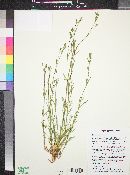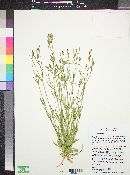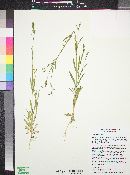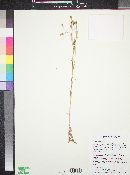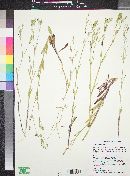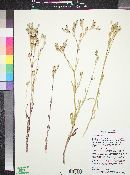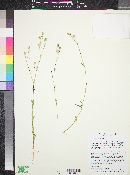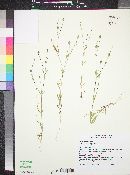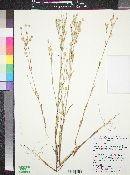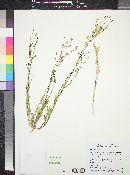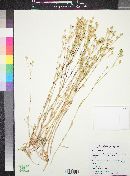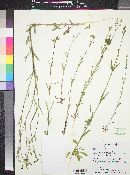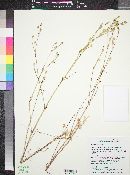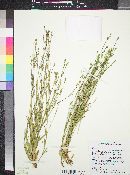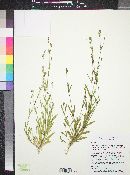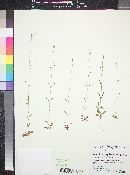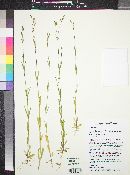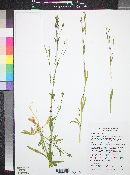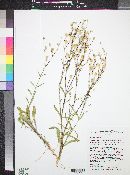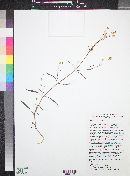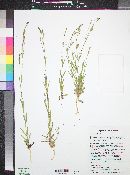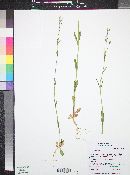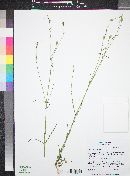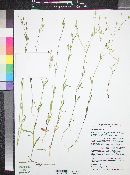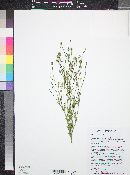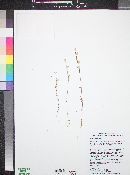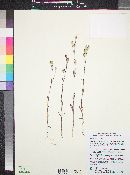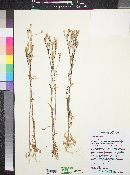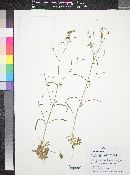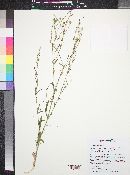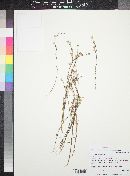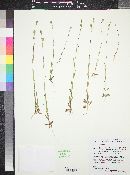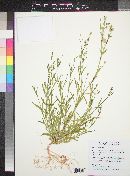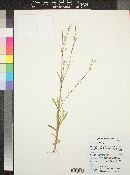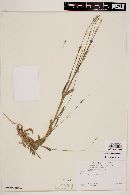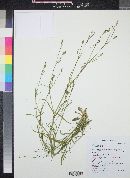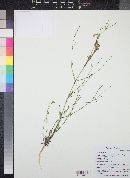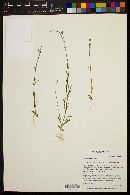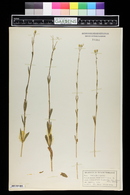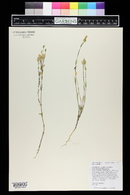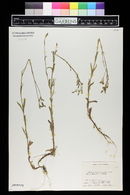Silene antirrhina
|
|
|
|
Family: Caryophyllaceae
Sleepy Catchfly, more...sleepy silene, campion, sleepy campion, catchfly
[Silene antirrhina f. antirrhina, moreSilene antirrhina f. apetala Farw., Silene antirrhina f. bicolor Farw., Silene antirrhina f. deaneana Fernald, Silene antirrhina var. confinis Fern., Silene antirrhina var. depauperata Rydb., Silene antirrhina var. divaricata B.L. Robins., Silene antirrhina var. laevigata Engelm. & A. Gray, Silene antirrhina var. subglaber Engelm. & A. Gray, Silene antirrhina var. vaccarifolia Rydb.] |
Plants annual; taproot slender. Stems erect, simple or branched, slender, to 80 cm, subglabrous to retrorsely puberulent especially proximally, distal internodes frequently glutinous. Leaves 2 per node; blade with margins ciliate toward base, apex acute to obtuse; basal blades oblanceolate, spatulate; cauline narrowly oblanceolate to linear, 1-9 cm × 2-15 mm, scabrous or puberulent, rarely glabrous on both surfaces. Inflorescences cymose, open, branches usually ascending, several- to many-flowered, 1-flowered in depauperate specimens. Flowers: mature calyx prominently 10-veined, campanulate to ovate, 5-9 × 3-5 mm, margins dentate, glabrous, veins parallel, with pale commissures; lobes usually purple, triangular, acute, ca. 1 mm; petals white, often suffused with dark red, rarely wholly dark red, limb ovate, usually 2-lobed, ca. 2.5 mm, slightly longer than calyx, rarely petals absent, claw narrow, appendages 0.1-0.4 mm; stamens included; styles 3; stigmas included. Capsules equaling calyx, opening by 6 teeth; carpophore less than 1 mm. Seeds dull gray-black, reniform, 0.5-0.8 mm diam., finely papillate. 2n = 24. Flowering spring-late summer. Dry, sandy or gravelly places, roadsides, fields, waste places, open woods, often appearing after burning; 0-2300 m; Alta., B.C., Man., N.B., Ont., Que., Sask.; Ala., Ariz., Ark., Calif., Colo., Conn., Del., D.C., Fla., Ga., Idaho, Ill., Ind., Iowa, Kans., Ky., La., Maine, Md., Mass., Mich., Minn., Miss., Mo., Mont., Nebr., Nev., N.H., N.J., N.Mex., N.Y., N.C., N.Dak., Ohio, Okla., Oreg., Pa., R.I., S.C., S.Dak., Tenn., Tex., Utah, Vt., Va., Wash., W.Va., Wis., Wyo.; Mexico; South America; adventive in Europe. The six varieties and forms of Silene antirrhina noted above were named on the basis of stature and flower color, but none appear to be worthy of recognition. The species is very plastic, being greatly affected by moisture, exposure, and nutrients.
Annual herb with a slender taproot 20 cm - 0.8 m tall Stem: slender, upright, unbranched or branched, nearly hairless to minutely hairy, upper internodes often sticky. Inflorescence: a branched, open cluster (cyme) of several to many flowers. Flowers: white, often reddish. Stalk upright. Stamens ten. Styles three. Sepals: fused at the base into a tube (calyx). Calyx tube 4 - 9 mm long, 3 - 5 mm wide, bell- to egg-shaped, ten-veined, with five short lobes. Lobes usually purple, about 1 mm long, and triangular with a pointed tip. Petals: five, white, often reddish, slightly longer than the calyx, egg-shaped, narrowly clawed, two-lobed. Fruit: a dehiscent capsule, three-chambered, opening by six teeth, 4 - 10 mm long, equal to calyx. Seeds dull grayish black, kidney-shaped, roughened. Basal leaves: reverse lance-shaped to spatula-shaped. Stem leaves: opposite, two per node, stalkless, 1 - 9 cm long, 2 - 15 mm wide, narrowly reverse lance-shaped to linear with a blunt to pointed tip, rough or minutely hairy, fringed with hairs near the base. Similar species: No information at this time. Flowering: mid-May to late July Habitat and ecology: Locally abundant in sandy, disturbed soils. Also found in sand barrens and along railroads. Occurence in the Chicago region: native Etymology: Silene probably comes from the Greek word sialon, meaning saliva, referring to the sticky secretion on many of these plants. It may also have come from the word seilenos, referable to Silenus-a foam-covered, drunken character in Greek Mythology. Author: The Morton Arboretum Wiggins 1964, Jepson 1993, Kearney and Peebles 1969, Allred and Ivey 2012, Heil et al. 2013, FNA 2005 Duration: Annual Nativity: Native Lifeform: Forb/Herb General: Annual herb, to 80 cm tall, from a slender taproot; stems slender and erect, sparingly branched or unbranched, mostly glabrous, with sticky brown or red bands on the upper portions of the stems. Leaves: Opposite and sessile along the stems; blades linear to oblong-lanceolate, 2-5 cm long and 2-12 mm wide; basal leaves often have ciliolate margins, especially near the leaf bases. Flowers: Pink to white, in diffuse terminal panicles, on slender pedicels 1-3 cm long; sepals 5, united into a subcylindric tube, 6-7 mm long in flower, expanding to be 7-9 mm long and ovoid in fruit, prominently 10-nerved, and topped with 1 mm long teeth; petals 5, exceeding calyx teeth about 1 mm, white, bright pink, or tipped with deep rose, each petal shallowly cleft into 2 lobes at the tip. Fruits: Capsules 6-8 mm long, ovoid, about the same length as the calyx, splitting open by 6 short teeth; containing many tiny light reddish-brown seeds, less than 1 mm long. Ecology: Found on open sandy hills, often in burned areas or other weedy locations, below 8,500 ft (2591 m); flowers March-May. Distribution: In every US state and the southern Canadian provinces. Ethnobotany: Unknown, but other species in the genus have uses. Etymology: Silene may refer to the mythical Silenus, the intoxicated father of Bacchus, who was described as covered in foam, perhaps alluding to the viscid nature of many species of Silene; antirrhina makes reference to Antirrhinum, the genus of cultivated snapdragons, which have similar leaves. Synonyms: Silene antirrhina var. confinis, S. antirrhina var. depauperata, S. antirrhina var. divaricata, S. antirrhina var. laevigata, S. antirrhina var. subglaber, S. antirrhina var. vaccirifolia Editor: SBuckley 2010, AHazelton 2017 Annual, 2-8 dm, often puberulent below, glabrous above except usually for some glutinous bands below the upper nodes; basal lvs oblanceolate to spatulate; cauline lvs oblanceolate to linear, 3-6 cm נ9-12 mm, the margins ciliate near the base; infl open; fls mostly ±numerous; cal 4-10 mm, 10-nerved; pet white or pink, equaling or exceeding the cal, 2-lobed, or obsolete, the appendages minute or none; carpophore 1 mm; fr 4-10 mm, 3-locular; seeds 0.5-0.8 mm wide, papillate; 2n=24. Sandy soil and waste places, through the U.S. and s. Can., apparently native. Summer. Gleason, Henry A. & Cronquist, Arthur J. 1991. Manual of vascular plants of northeastern United States and adjacent Canada. lxxv + 910 pp. ©The New York Botanical Garden. All rights reserved. Used by permission. From Flora of Indiana (1940) by Charles C. Deam This species is variable. It prefers a very sandy habitat and is frequent in railroad ballast throughout the state. It is less frequent in fallow and cultivated fields, pastures, and waste places and along roadsides. Our manuals give this species as a native of the United States. I do not believe, however, that it was a native of Indiana. Our earliest authors either do not list it or give it as a plant of waste places. M'Murtrie, who published a flora of Louisville in 1819, does not list it, nor does Riddell, who published his "Flora of the Western States" in 1835. Short, Peter & Griswold published a catalogue of the plants of Kentucky in 1833, and they do not list it. Neither do they list it in any of their four supplements, the last published in 1840. Lapham lists it from Illinois in his flora published in 1857. Dr. Clapp records that he found it in 1835 east of Corydon and in the "barrens." Young, in his catalogue of the plants of Jefferson County published in 1871, does not list it. J. M. Coulter, however, reports it in his catalogue published four years later. Schneck, who published a flora of the Lower Wabash Valley in 1876, says: "In poor grounds anong cereals, common." Bradner, Phinney, and Van Gorder did not report it in their floras. Apparently it has become a frequent weed during the past 50 years. I believe it has been introduced mostly in grass and grain seed and by railroads. A form with the internodes lacking the glutinous band is known as f. deaneana Fern. It occurs with the species and I found it in Posey County associated with the species and the variety [var. divaricata]. [Variety divaricata, a taxon with thinner leaves and more widely spreading inflorescence,] has been reported from the dune area by Peattie. Evidently local and rare in the state. I have it from Kosciusko and Warrick Counties. …… Indiana Coefficient of Conservatism: C = 0 Wetland Indicator Status: N/A |
|
|
|

